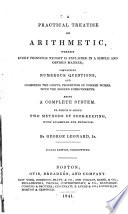 | Thomas Dick - 1840 - 370 pages
...machines, the principles on which their energy depends ; the properties of the mechanical powers — the lever, the wheel, and axle, the pulley, the inclined plane, the wedge and the screw — and the effects resulting from their various combinations. From the investigations... | |
 | George Leonard (jr.) - 1841 - 350 pages
...MACHINES, OFTEN CALLED MECHANICAL POWERS. LESSON 194. There are usually reckoned six simple machines ; the lever, the wheel and axle, the pulley, the inclined plane, the screw, and the wedge. The force that raises a weight, or overcomes a resistance, is called the power. The power is usually... | |
 | Benjamin Greenleaf - 1841 - 334 pages
...The body which receives motion from another, is called the weight. The mechanical powers are five, the Lever, the Wheel and Axle, the Pulley, the Inclined Plane, the Screw and the Wedge. LEVER. The lever is a bar, movable about a fixed point, called its fulcrum or prop. It is in theory... | |
 | George Leonard - 1841 - 354 pages
...MACHINES, OFTEN CALLED MECHANICAL POWERS. LESSON 194. There are usually reckoned six simple machines ; the lever, the wheel and axle, the pulley, the inclined plane, the Screw, and the wedge. The force that raises a weight, or overcomes a resistance, is called the power. The power is usually... | |
 | 1837 - 800 pages
...the cord, and the inclined plane. They have been, however, differently enumerated by others ; viz., the lever, the wheel and axle, the pulley, the inclined plane, the wedge and the screw, being six in number. The first class in eludes every machine which is composed... | |
 | George Leonard - 1841 - 356 pages
...MACHINES, OFTEN CALLED MECHANICAL POWERS. LESSON 194. There are usually reckoned six simple machines ; the lever, the wheel and axle, the pulley, the inclined plane, the icrew, and the wedge. The force that raises a weight, or overcomes a resistance, is called the power.... | |
 | George Leonard (jr.) - 1841 - 352 pages
...MACHINES, OFTEN CALLED MECHANICAL POWERS. LESSON 194. There are usually reckoned six simple machines ; the lever, the wheel and axle, the pulley, the inclined plane, the tcrew, and the wedge. The force that raises a weight, or overcomes a resistance, is called the power.... | |
 | Denison Olmsted - 1842 - 384 pages
...elements of machinery are found in what are called the Mechanical Powers. They are six in number, viz. the Lever, the Wheel and Axle, the Pulley, the Inclined Plane, the Screw, and the Wedge. THE LEVEH. 117. The LEVER is an inflexible bar or rod, some point of which being supported, the rod... | |
 | William Grier - 1842 - 320 pages
...the other. 2. The simple machines, or those of which all others are constructed, are usually reckoned six : the lever, the wheel and axle, the pulley, the inclined plane, the wedge, and the screw. To these the funicular machine is sometimes added. 3. The weight signifies the... | |
 | Benjamin Greenleaf - 1843 - 340 pages
...thenotccr. The body which receives motion from another, is called the weight. The mechanical powers are six, the Lever, the Wheel and Axle, the Pulley, the Inclined Plane, the Screw and the Wedge. LEVER. The lever is a bar, movable about a fixed point, called its fulcrum or prop. It is in theory... | |
| |